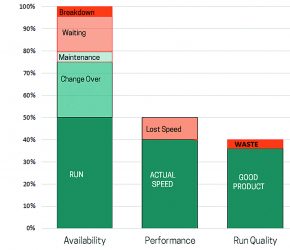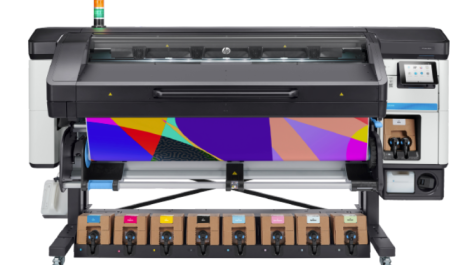Data can tell a print business a lot about itself, and if analysed and deployed correctly can help to improve productivity and profitability. Andy Knaggs considers the factors involved.
Addressing Kodak’s 2018 GUA European Conference in October, Allan Brown, general manager for Unified Workflow Solutions and vice president of Kodak’s Software Solutions Division, discussed a topic that many printers are only just coming to terms with: their own data.
‘Our vision was that we wanted to aggregate the big data that comes out of the shop and make that data usable in order to make the shop smarter,’ he said. ‘We look at applications in print shops: platesetters, digital printing devices, software and servers. All of them generate an immense amount of data, and you need data analytics and artificial intelligence to dig into that data and to interpret it in order to give printers helpful insights and identify sources of savings.
‘We bring things together: smart devices, big data, AI, analytics. This means we are entering the era of smart manufacturing. That is the evolution that we see going on in the industry today.’
The era of smart manufacturing … has it reached you yet? The chances are that, like most printers, you’re still working up to making such a thing reality. If you haven’t even started yet, perhaps the words of Anthony Thirlby, once a determined pursuer of the smart factory at Swindon’s ESP Colour, and now global head of Heidelberg’s Commercial Print Segment, will deliver a significant push.
‘I have seen a huge trend in the last two years, with more and more companies worldwide really starting to engage on what can be achieved. Analytical behaviour and ensuring cost effectiveness for their businesses are real drivers for all print service providers. I would say I have seen over 600 companies in the last four years: the true embracers are around 15%; the businesses just starting are around 50%, and 35% are now realising that they need to become engaged in the data space.
‘Within five years I would say we will be above 80%, as it is pivotal to the success of the industry moving forward.’

Time well spent? Analysis from Active Data Metrics helps understand what the press is really doing when.
Efficiency and profitability
It seems clear therefore that the use of operational data by printers to drive their own efficiency and profitability is going to be an increasing factor in this industry. There are many aspects to this, including data collection from machines, the ability of software such as MIS, web-to-print and production workflow to connect with each other and present an accurate data picture, and the cultural challenges of implementing new ways of working within a print business. Many printing firms, for example, continue to use spreadsheets and manual job bags on a daily basis. They have been doing so for many years, and are reluctant to change tried and trusted methods for new digitised ways of operating.
Set against this, almost every printer is experiencing the demand for greater numbers of shorter run jobs. They need to be more efficient both in production and administration to preserve what margins there are. Data and technology can help them realise smarter ways
of working.
‘I think it’s a direction we have got to go,’ states Wayne Beckett, joint managing director of Resolve Business Management, which is selling the Keyline MIS in the UK. ‘These days it’s all about much shorter run jobs with smaller margins. As soon as you’ve got someone doing manual work on a job you have lost your margin straight away.’
The cloud-based Keyline MIS is part of a new breed of MIS software, one developed with integration and data exchange at its core. ‘Keyline is the spine; you can feed data into it from just about every other system,’ Mr Beckett continues. ‘It gets you away from job bags and manually scribbling how many sheets were used on a job. You don’t need manual input of data, that’s the USP. For example, a web-to-print order goes through our Enfocus Switch app, so Keyline gets a completed order with preflighted artwork that the operator can just put into the digital press; there’s no artwork checking needed. That’s lights-out prepress.
‘The market knows that lights-out prepress and fully automated production scheduling is definitely the way things are going, but it’s a massive leap of faith for these companies to automate something that’s fundamentally at the core of the business. People are used to job bags, but years ago people were used to machines with no automation at all; they had to get used to digital presses. We got around those ones.’

Wayne Beckett says that ‘lights out prepress’ is the way ahead but accepts ‘it’s a massive leap of faith’ for many
Legacy MIS
However, it might not be so easy for many print companies, which have invested a great deal of time and money in their MIS systems over several years, sculpting their businesses around them, to just move onto new technology with simpler data connections. This is a situation recognised by Alan Dixon, founder of pre-media software distributor Workflowz, who otherwise contends that becoming a data-savvy printer is easier than ever today.
‘On the whole people don’t kick out an MIS, as it’s taken so long to build their business around it,’ he says. ‘There are opportunities with a new generation of systems that are more dynamic and fluid, opportunities to build that migration. Clearly it should be easier to get smarter with data these days because of technological advances such as the speed of networks. We also have the benefit of another 10 years of knowledge with digital systems, and we should combine that experience with new technology.’
Active Data Metrics is a company that exists to help printers (and companies in other sectors) to improve their productivity through accurate measurement. Its solution can combine sensors on both old and new machines alongside data capture to tablet by operators. Measurement is focused on key metrics: how much time the presses spend running, how fast they are running, and how much waste is being produced. It is, however, a system that allows simple but often overlooked factors to be identified and recorded: the fact that the pallet truck is late in clearing pallets away, that the next paper reel is not at the end of the press when it should be; these kinds of things happen all too often and cause lost productivity. The operator records this on his tablet, and the production director sees it straight away so that steps can be taken to ensure this does not happen again.
Matthew Peacock, director of Active Data Metrics, comments: ‘What matters is that the management understands that it needs to know how it is running, and that it uses that information with a good process for reviewing and using it. Most lost production time is not lost because the operator is lazy, but because the raw materials are not there at the machine, or because the information on the work ticket was wrong. We combine data picked up on the machine with data that is input by operators.’

Workflowz Alan Dixon – the business may have been sculpted around the existing MIS
Look at labour
For consultant John Charnock of Print Research International there is too much emphasis within the industry on machine efficiency. He said that too many firms are preoccupied with this when, in fact, understanding labour efficiencies is just as important.
Mr Charnock continues: ‘There is tonnes of data out there, but who’s using it? Probably very few because no-one has written a functional dashboard for the management that will actively generate a report. Many businesses probably don’t even know what to look at. I would say that, yes, downtime is important, but also look at labour flexibility and labour utilisation. Tracking the person is as important as tracking the kit ‘Cost of sales is another: many print businesses are getting five thousand jobs per day, not per month. If I had to pick one thing that’s critical it would be forecasting and visibility. We are obsessed with machinery, but getting visibility of sales data and the peaks and troughs allows you to gear labour up or down to fulfil those peaks and troughs. Ten per cent of cost is capital equipment and 30% is labour – which one should you
focus on?’
The aspect of forecasting is highlighted also by wide-format MIS provider Clarity Software, which advocates getting to grips with data as soon as possible to maximise effectiveness. ‘Review your quoting history and job closure rates, the reasons behind wins and losses, your star sales performers, your most effective campaigns and your biggest selling products,’ commented Imran Hussein, digital marketing manager at Clarity. ‘Businesses can make accurate forecasts and know exactly how profitable every job will be.’

Heidelberg’s Anthony Thirlby – the drive must come from senior management and it must be sustained
Leading the way
Once a company begins to measure and gather data for analysis, and identifies ways to enhance its performance and profitability, then management of cultural aspects must come alongside implementation of the changes.
‘This kind of project shines a light in dark corners, and companies have to provide good leadership and be encouraging,’ says Matthew Peacock. ‘If the information is shared and used constructively it can transform a business.’
Anthony Thirlby also highlights the need for management commitment to making these data-informed improvements, saying: ‘The senior managers have to be the initial drivers, in direct correlation with the relevant areas, to ensure the requirement is clear and everyone understands why the business requires it.
‘From there it is about consistency of measurement. A lot of people stop after a few weeks, and this can have a very negative effect on the organisation. It has to be a culture of business evolution, not revolution, and creating a best-in-class mindset through every area.’
Be prepared for eyebrow-raising results too, he warns: ‘The first thing is believing the data that you are provided with. It can sometimes be a big shock to an organisation when it starts to evaluate its true operational performance.’ dp





